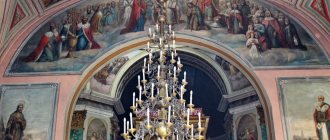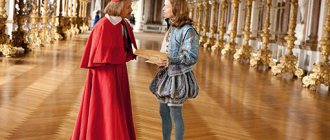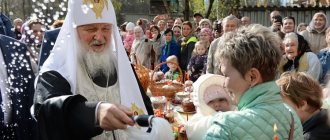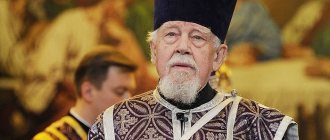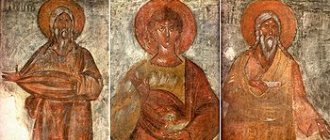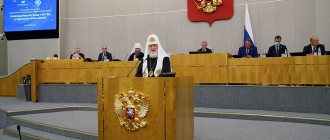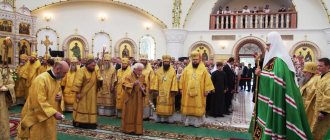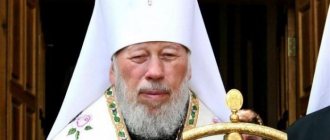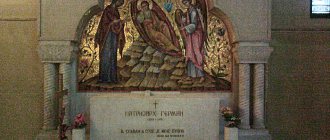On February 12, 2021, a meeting between the Patriarch and the Pope took place. The meeting took place in the building of the José Martí International Airport in the capital of Cuba, Havana.
This was the first meeting in history between the Russian Orthodox Church and the Catholic Church at such a high level.
This was the first high-level meeting between the Orthodox and Catholic churches, which had been prepared for about 20 years. Pictured are Pope Francis and His Holiness Patriarch Kirill
background
Personal meetings between the Pope and the Patriarch of Moscow and All Rus' have not previously taken place. Preparations for the meeting in 2021 have been going on for 20 years. In 1996-1997, negotiations were held to organize a meeting between Patriarch Alexy II and Pope John Paul II, but it did not take place due to problems on which the parties could not reach agreement [1]: primarily the proselytism of the Catholic Church in the canonical territory The Russian Orthodox Church and Orthodox churches captured by the Uniates in Western Ukraine. Thus, in May 2007, Metropolitan Kirill noted [7]:
“We have never ruled out in principle the possibility of the Pope coming to Russia or his meeting with His Holiness Patriarch Alexy II of Moscow and All Rus' on the territory of another country. But, in our deep conviction, this historical event should testify to positive changes in relations between the two Churches.”
Negotiations about the possibility of a meeting were also conducted with Pope Benedict XVI until his resignation in March 2013[1]; in 2006, the future Patriarch Kirill, as chairman of the Department for External Church Relations of the Moscow Patriarchate, visited Rome, where he met with the pontiff [8].
In November 2014, Pope Francis, answering a question from a TASS correspondent on board a plane upon returning from a trip to Istanbul, where he met with Patriarch Bartholomew I of Constantinople, stated that he was ready to meet with Patriarch Kirill anywhere and at any time [2].
In 1054 there was a division into the Roman Catholic and Orthodox Churches
First, let's look at history. During the schism of the Christian Church, which occurred in 1054, there was a division into the Roman Catholic Church in the West, centered in Rome, and the Orthodox Church in the East, centered in Constantinople.
This division has not yet been overcome. The Russian Orthodox Church became one of the largest churches in the world, which became independent from the Church of Constantinople from 1448.
1589
from this year, Moscow metropolitans received the dignity of patriarchs
The Council of Florence, which took place from 1438 to 1445, was attended by Pope Eugene IV and Patriarch Joseph II of Constantinople. The Primate of the Russian Church, Metropolitan Isidore of Kiev and All Rus', was also present at the Florence Council.
Unfortunately, the Patriarch of Constantinople did not live to see the signing of the union, but managed to write in writing an agreement approving Catholic changes to the Creed.
Metropolitan of Kiev and All Rus' Isidore - was present at the Council of Florence in 1438, when the Patriarch of Constantinople wrote a written agreement approving changes to the Creed
When Metropolitan Isidore returned to Moscow, he read out the text of the union, and by order of Vasily II he was arrested. The council's decisions on union were subsequently completely rejected by all Orthodox churches.
chronology of events
Preparation
The organization of the meeting between Pope Francis and Patriarch Kirill took two years and the final decision was made in the fall of 2015.
The fact that this meeting will certainly take place was announced on January 26, 2016 by the Italian expert Sandro Magister in the blog of the newspaper Repubblica: “In less than a month they will get closer to each other: Francis will be in Mexico, Kirill will be in Cuba. What is needed for a historical meeting”[9].
The master schematically showed how the meeting was organized, and that the main person in “shuttle diplomacy” was Cuban leader Raul Castro: “The first meeting in history between the head of the Roman Church and the head of the “Third Rome” may unexpectedly take place under the tropical sun. In fact, at the same time that dad will be in Mexico, Kirill will be in Cuba, where Raul Castro personally invited him back in May last year, during his visit to Moscow. Then, in 2015, Raul Castro, on his way back from Moscow, visited Rome, where he met with Francis. They discussed the pope's visit to Cuba, which took place in September 2015. "Castro probably informed the pope about his negotiations with Patriarch Kirill and Russian President Putin."
This meeting was first discussed publicly in November 2014, when, upon returning from Turkey, Pope Francis said: “As for Patriarch Kirill... I believe that there is a common desire to meet, and I know that he agrees with this. I told him: “I will come where you want. You call me and I will come." And he also has such intentions.”
The meeting was announced by both parties on February 5, 2021, and on the same day the final decision was made to hold it on February 12. Up to this point, various types of agreements had taken place regarding the date, place and content of the meeting, in particular, the declaration proposed for signing, the text of which was agreed upon until late in the evening of February 10 and took up 10 pages [10][11][12].
For the meeting of the heads of churches at Havana José Martí Airport, which is the main international air hub of the country, the state protocol room of the first terminal, as well as a press room, were prepared [13].
Patriarch Kirill arrived in Havana on February 11 [14], Pope Francis arrived on the afternoon of 12, shortly before the start of the meeting [15].
progress of the meeting
The meeting began at 14:25 [16]. Patriarch Kirill and Francis, dressed in the usual vestments used outside of divine services, kissed and took photographs together[17], and then sat in chairs installed on either side of a wooden crucifix[17]. Quite quickly, the journalists were asked to leave the hall [18]. As the Italian news agency ANSA reported, the first words of the pope addressed to the Patriarch were “Finally, we are brothers.”
, the Primate of the Russian Orthodox Church replied:
“Now everything is easier
.
“It is obvious that this is God’s will
,” Francis said [17].
In total, the meeting lasted more than two hours. The Patriarch and the Pope discussed a number of important issues, touching on the persecution of Christians in the Middle East, military-political confrontation and religious schism in Ukraine, and the crisis of the family in modern society [18]. The heads of churches also spoke about the future of Christians, the further development of cooperation between the Russian Orthodox Church and the Catholic Church, possible joint projects, in particular, the exchange of pilgrims [19]. Kirill and Francis communicated in their native languages - Russian and Spanish, with the help of two translators [17].
An exchange of gifts also took place: the Patriarch presented the pope with a copy of the Kazan Icon of the Mother of God and his book “Freedom and Responsibility” in Spanish, Francis, in turn, presented Kirill with a piece of the relics of St. Kirill and a communion cup [18].
Following the meeting, the Patriarch and the Pope solemnly signed a joint declaration consisting of 30 points [18].
As Patriarch Kirill believed, the meeting in Cuba should be a good sign of hope for the good will of the people
It is necessary to say why this meeting was so important? As Patriarch Kirill of Moscow said, their meeting in Cuba should become an event with a sign of hope for the good will of all people.
The meeting will be of particular importance against the backdrop of worsening international tensions.
The reason for the meeting of churches was the activities of the Ukrainian Greek Catholic Church.
What kept this meeting from happening for so long? All these years, the main problem in the relationship between the two churches and heads has been the activities of the Ukrainian Greek Catholic Church. Its followers live in the West of Ukraine, while maintaining Orthodox rituals, and at the same time everyone recognizes the Pope as their head.
These followers defeated three dioceses of the Moscow Patriarchate in Western Ukraine at the turn of 1980-90. When the transfer of the Ukrainian Greek Catholic Church from Lviv to Kyiv took place, a very persistent desire of this church began to assign itself the status of patriarchy.
So why did this meeting become possible now? According to many experts, it is precisely the meeting between the two heads of churches that should move closer due to the fact that Francis is not considered an adherent of authoritarian Catholicism.
Among other things, recently the state often finds itself on the side of Russia. But this also does not mean that the contradictions between the Russian Orthodox Church and the Vatican have been overcome, because doctrinal differences have not been overcome. And also those disagreements of a practical nature that darken the life of both churches have not been overcome.
The contradictions between the Russian Orthodox Church and the Vatican have been overcome.
But Patriarch Kirill is confident that in matters of universal human values, the positions of the heads of churches are very close to each other. But also, the main factor that influenced the meeting was the persecution of Christians in the world.
The situations that have developed in the Middle East, North and Central America, where extremists are carrying out genuine genocide of the Christian population. This requires certain and urgent measures, and even more so, closer interaction between the churches.
As Metropolitan Hilarion of Volokolamsk said:
“In the current tragic situation, it is necessary to put aside internal disagreements and join forces to save Christianity in those regions where it is subjected to severe persecution.”
Metropolitan Hilarion of Volokolamsk believed that in the current situation it is necessary to put aside all the disagreements that are occurring between the Orthodox and Catholic churches.
See also the article Andrei Tkachev: biography, family photo
Therefore, on February 3, the Consecrated Council of Bishops of the Russian Orthodox Church, which ended in Moscow, decided that in 2021 every effort should be made to ensure that the meeting between Pope Francis and Patriarch Kirill takes place.
It was then that it was decided that the meeting required urgent action.
reaction
Representatives of mass religion around the world reacted favorably to reports of the meeting between the Patriarch and the Pope. The meeting of the heads of the two churches was welcomed, noting its importance and historical significance, by representatives of Catholicism and the Orthodox Church of Russia and other states[20], Belarus[21], Hungary[22].
Press Secretary of the Russian President Dmitry Peskov called the meeting between Kirill and Francis a mutual step towards Russia and the West[23].
It is no coincidence that the meeting of Patriarch Kirill and Pope Francis in Havana took place under the protection of the Kazan Icon of the Mother of God. This is a special sign, because this illustrious list was once handed over by the Pope (John Paul II in 2004 - Ed.)[24].
- Metropolitan Feofan (Ashurkov)
So we witnessed the meeting of the Russian Patriarch and the Pope. Who would have thought a year, two, three ago that this would happen so quickly? Nevertheless, it happened. And everyone felt that this was not just a diplomatic meeting. Many felt - both believers and non-believers - that this meeting revealed some truth about life. Although, in order not to arouse all sorts of passions and discord, theological issues were not discussed there[25].
— Dmitry Gasak
We agree with the conclusion about the need for interaction between Catholics and Orthodox Christians in preserving traditional Christian ethics and ethics...
We evaluate the Document adopted following the meeting of His Holiness Pope Francis and His Holiness Patriarch Kirill of Moscow and All Rus' as a serious church-political program that orients Orthodox and Catholic peoples towards the protection of traditional Christian values and ideals, without which humanity has no future[26]
— Union of Orthodox Women
After the meeting between the Patriarch and the Pope, the opinions of many Orthodox clergy diverged
The meeting of the Patriarch and Pope Francis was perceived by everyone as a good sign all over the world. For example, priest Oleg Stenyaev notes that the dialogue between Orthodoxy and Catholicism was quite normal. He also believes that it is necessary to discuss not only what unites, but also what completely separates.
Without this literary communication cannot exist. Father Oleg says that it is the Orthodox Church that should call on the Roman Church to reconsider those innovations that contradict the unified church before 1054.
Priest Oleg Stenyaev believes that the meeting between the Patriarch and the Pope was quite normal and successful
Many others also commented on the positive impact the meeting had on both churches. Dmitry Peskov, the president's press secretary, called the meeting a mutual step towards Russia and the West.
Roman Lunkin, a leading researcher at the Institute of Europe, believes that this meeting carries an important task of returning Christianity to world politics.
But there was also criticism from a number of the Orthodox Church. Archpriest Andrei Tkachev said in his program that the task of the evil one is to split the church from within.
Priest Andrei Tkachev considers the meeting between the Patriarch and the Pope not entirely pleasant. In his program he also said that the task of the evil one is to split the church from within
Also, Bishop Longin of the Ukrainian Orthodox Church stated that the joint declaration was heretical in nature, and even said that he would never remember Patriarch Kirill. Many clergy opposed this meeting and the signing of the declaration.
Pope Francis himself stated that he was very inspired by the outcome of the meeting with Patriarch Kirill:
“I felt an inner joy that was truly from the Lord.”
Francis
Pope
Patriarch Kirill, after sharp negative criticism, explained:
“Of course, this is all an ideal image. But if there is no ideal, then there is no goal. And therefore, we jointly called on the whole world (the Christian world and the whole world in general) to move together towards this goal.”
Kirill
Patriarch
By leaving a comment, you accept the user agreement
fruits of the Havana meeting
expansion and deepening of the Orthodox-Catholic dialogue
The meeting in Havana established new principles of relations between the Vatican and the Russian Church. According to the papal nuncio to Russia Celestino Migliore:
“The essence of the relationship between the Moscow Patriarchate and the Roman Church was formulated by His Holiness interlocutors during their February meeting in Havana. Patriarch Kirill spoke about a new phase, about constructive inter-Christian dialogue, during which we are looking for common spaces in which we can cooperate. He confirmed this conviction during a courtesy visit I paid him in mid-November and during recent meetings with Cardinals Kurt Koch and Giuseppe Bertello. Pope Francis said that religious leaders can and must work together, in common dependence on God the Father, for the sake of peace, the spread of the preaching of the Gospel, for the good of all peoples of the Earth.”[27]
Patriarch Kirill:
Our meeting in Havana in February of this year will remain unforgettable for me, which gave new impetus to friendly dialogue and cooperation between our Churches for the sake of peace, justice, strengthening moral values in society and overcoming differences between Christians[28].
Metropolitan Hilarion (Alfeev):
“Today many areas of interchurch cooperation are actively developing. Their new prospects were outlined by the historic meeting of His Holiness Patriarch Kirill and Pope Francis in Havana”[29].
The declaration of the Patriarch and Pope “will serve as a beacon for a long time to guide Christians of two traditions - Orthodox and Catholic. The declaration spoke important words both about the Gospel as a common basis for believers in the East and West, and about how to implement the Gospel commandments in modern difficult conditions. This declaration is a guide to action.”[30]
“The meeting in Havana with Pope Francis showed the high interest in dialogue with the Russian Orthodox Church on the part of the Catholic world on the entire range of issues that we are discussing today”[31].
On September 15, 2021, a meeting was held in the Vatican with Metropolitan. Hilarion with Pope Francis, during which the development of Orthodox-Catholic relations after the meeting of Patriarch Kirill and Pope Francis was discussed. “The parties noted the positive dynamics of interchurch interaction on a number of topical issues raised during the meeting in Cuba”[32].
The meeting took place outside the “European context” - that is, the history of the schism:
“When we met, I said the following words at the airport: “You and I, in my opinion, are meeting at the right time...”. And he added: “...and in the right place,” because we met outside the European context, which was colored by the entire history of the division of the Orthodox and Catholic Churches. The history of these European contradictions between the two Churches still dominates the consciousness of Catholics and Orthodox Christians. And the meeting in Havana gave us the opportunity to move a little away from this historical European context.
But I think the emphasis should be on the first words: the right time.
The Patriarch of Moscow has never met the Pope before. And I felt an urgent need to meet with the head of the Catholic Church, and first of all, to discuss those issues that are most of concern in terms of global development. And I found complete understanding. We signed, as you know, a declaration that reflects the position of the two Churches”[33].
signing of the Balamand Union
on May 20, 2021 Met. Hilarion (Alfeev) noted that the declaration signed by Pope Francis and Patriarch Kirill is tantamount to approval of the Balamand Union:
The Joint Statement of the Patriarch and the Pope clearly states that “the method of “uniatism” of previous centuries, which involved bringing one community into unity with another by separating it from its Church, is not the path to restoring unity.” “This has been discussed before, including in the document of the Mixed Commission on Orthodox-Catholic Dialogue, signed in Balamanda in 1993. However, the Balamand Document was not approved at one time by Pope John Paul II (as well as by the Russian Orthodox Church under Patriarch Alexy. - Ed.). Now the head of the Roman Catholic Church has directly confirmed what has become obvious not only to the Orthodox, but also to the Catholic participants in the dialogue. I consider this an important achievement.”[34]
intensification of theological dialogue
The IX theological interviews between the Russian Orthodox Church and the Catholic German Bishops' Conference (St. Petersburg, June 14-17, 2021) not only continued the tradition of regular interviews that began 30 years ago (1986), but also became a response to the call of His Holiness Patriarch Kirill and Pope Francis to consider the family as “the natural center of human life and society” and testify to it as “the path to holiness.” Thus, the desire for close cooperation noted in their Joint Declaration in Havana in February 2021 found its concrete embodiment in the Conversations[35].
expansion of relations with Uniates
Metropolitan Hilarion noted that in pursuance of the decisions taken in Havana and concerning joint measures to protect the Christian population from the actions of terrorists, the Moscow Patriarchate is developing relations of cooperation and support, in particular, with the Uniate “Eastern Catholic Churches” of the Middle East region[36].
Orthodox-Catholic delegation to the Middle East
On April 7, 2021, an Orthodox Catholic delegation from Russia visited on behalf of the Moscow Patriarchate and the Vatican with the aim of practical implementation of some agreements reached at the meeting of His Holiness Patriarch Kirill of Moscow and All Rus' and Pope Francis in Havana.
The delegation included the head of the Catholic Archdiocese of the Mother of God in Moscow, Archbishop Paolo Pezzi, the secretary of the Department for External Church Relations for Inter-Christian Relations, Hieromonk Stefan (Igumnov), representatives of the Kirche in Not Foundation, priests Andrzej Galemba and P. V. Gumenyuk[37] .
Orthodox-Catholic cultural cooperation
September 19, 2021 Met. Hilarion (Alfeev) and Cardinal Kurt Koch noted the fruitful development of Orthodox-Catholic cooperation in the field of culture[38].
project “Images of the Saints of the Undivided Church”
(June 2021 -)
project curator Sergei Chapnin. According to him, the impetus for the implementation of this long-cherished idea was given by the meeting of Pope Francis and Patriarch Kirill in Cuba in February 2021. This historical meeting, Chapnin believes, “can open a new page in the history of the dialogue between Western and Eastern Christianity, which has never been interrupted, but at times, including quite recently, has gone through difficult times”[39].
pilgrimage
“At the meeting between the Pope and the Patriarch it was said that we should be more open to each other in terms of pilgrimage. For example, a huge stream of Orthodox pilgrims goes to the relics of St. Nicholas in Bari, Italy, every day. And pilgrims from the Catholic Church also come to Orthodox shrines. But we can intensify these two flows, because it is very important that people meet each other and have access to the shrines located in another Church”[30].
The Pope gives the Patriarch “a piece of the relics of St. Francis"
On November 20, 2021, Pope Francis congratulated Patriarch Kirill on his 70th birthday:
“I am deeply grateful to you for your personal contribution to the rapprochement of our Churches and remember with special feeling our historic meeting in Havana.
Once again expressing gratitude for the particle of the honorable relics of St. who was given to me. Seraphim of Sarov, I am pleased to present you with a piece of the relics of St. Francis of Assisi, my heavenly patron. Filled with Easter joy and thirsting for peace for all God's creatures, Francis is rightfully considered one of the closest to St. Seraphim of Saints. May these two amazing saints of God, already united in paradise, intercede for us, so that we work even more unitedly to achieve peace and complete unity, which Jesus Christ prayed for.”[40]
transfer of relics
— Is it possible to bring the relics of the apostles Peter and Paul or St. James from Spain to Russia from Rome?
- I think this is quite possible. And I think that if the relics of those saints who are revered in our Church and who are kept by Catholics are brought to Russia, our believers will perceive this with great spiritual uplift. And, of course, the reverse movement is also possible here, that is, the shrines of the Russian Orthodox Church can be exported to the West for some time so that believers of the Catholic Church can venerate them[30].
Transfer of the relics of St. Nicholas the Wonderworker
On May 21, 2021, on the eve of the feast of the transfer of the holy relics of St. Nicholas from Myra in Lycia to Bari, an ark with a particle of the holy relics of the saint was delivered to Moscow from Bari. According to the website patriarchia.ru, this event became possible thanks to the agreement reached during the meeting of the Patriarch of Moscow and All Rus' Kirill and Pope Francis in Havana on February 12, 2021[41].
Forensic experts removed from the shrine containing the relics the ninth rib of the saint, which is located next to the heart. It was placed in a special ark[42].
rib of St. Nicholas.
On May 21, 2021, Chairman of the Department for External Church Relations of the Moscow Patriarchate, Metropolitan Hilarion of Volokolamsk, celebrated the Divine Liturgy in the crypt of the Basilica of St. Nicholas in Bari (Italy) together with Metropolitan Longinus of Saratov and Volsk, Bishop Veniamin of Ardatov and Atyashevsk, Bishop Tarasius of Balashov and Rtishchevsk, Bishop of Pokrovsk and Nicholas Pachomius, Bishop of Serdobsk and Spassk Mitrofan, head of the Moscow Patriarchate Office for Foreign Institutions, managing the parishes of the Moscow Patriarchate in Italy by Bishop Anthony of Bogorodsk.
Present in the church were the Catholic Archbishop of Bari Bitonto, Monsignor Francesco Cacucci, the Secretary of the Pontifical Council for Promoting Christian Unity, Monsignor Andrea Palmieri, the Secretary of the Archbishop, Monsignor A. Romita, the Prior of the Basilica of St. Nicholas in Bari, Ciro Capotosto, the employee of the Pontifical Council for Promoting Christian Unity, Priest Iacinthos Destivelle, as well as Ambassador Extraordinary and Plenipotentiary of the Russian Federation to the Holy See A.A. Avdeev, mayor of Bari Antonio de Caro, head A.G. Guryev, President of the Center for Film Festivals and International Programs, Honorary Citizen of the City of Bari T.V. Shumova.
The small ark with part of the relics of St. Nicholas stood on the throne during the Divine Liturgy. After the dismissal of the service, the prior of the Basilica of St. Nicholas in Bari, Ciro Capotosto, moved the shrine to the upper church. After the censing, the reliquary, accompanied by the singing of the troparion to the saint, was placed in a specially made ark with an icon of St. Nicholas the Wonderworker, Archbishop of Myra in Lycia[43].
From May 21 to July 12, the shrine was in Moscow, and from July 13 to July 28 - in St. Petersburg, in the Alexander Nevsky Lavra[44].
In total, during the stay of the holy relics in Russia, 2,392,300 believers from Russia, Ukraine, Belarus, Moldova, and countries near and far abroad were able to venerate the shrine[45].
Priest Alexander Volkov called the bringing of the relics to Russia “a historical event that has yet to be comprehended.” “Approximately 2.5 million people, the flock of the Russian Orthodox Church, venerated the relics. This is a very significant number. The religiosity of people in our country is assessed differently, but the bringing of the relics showed that we live in an Orthodox country, and no additional confirmation is needed,” said the head of the Patriarch’s Press Service[46].
Transfer of the relics of the Holy Great Martyr Panteleimon
Ark for the relics of the Great Martyr Panteleimon.
On August 9, 2021, on the day of remembrance of the holy great martyr and healer Panteleimon, at the beginning of the Divine Liturgy, an ark with a particle of the relics of St. Panteleimon was solemnly delivered to the Peter and Paul Cathedral of the city of Gomel in front of a large crowd of believers. The shrine was delivered to Belarus by a delegation from Italy, headed by Bishop Locri and Gerace Francesco Oliva. The delegation was met by Bishop Stefan of Gomel and Zhlobin with a host of clergy of the Gomel diocese[47].
education
September 19, 2021 Met. Hilarion (Alfeev) and Cardinal Kurt Koch noted that an exchange program for study trips of priests and theology students from the Roman Catholic Church and the Moscow Patriarchate to Moscow and Rome, respectively, has been developed for a deeper acquaintance with the traditions, as well as the modern life of the two Churches. The interlocutors agreed that this project has great prospects and should be carried out on an annual basis[38].
The luxurious life of Patriarch Kirill
Vladimir Gundyaev, better known today as Patriarch Kirill, already knew from childhood which path in life he would choose. Born into a deeply religious family, unusual for those times, he realized his life’s calling quite early. Later, Kirill took monastic vows, after which his spiritual career (so to speak) began to grow by leaps and bounds.
Thus, already in the late 70s, the future Patriarch of All Rus' took the position of Archbishop of the Vyborg Diocese. He only became the first clergyman in 2009. The current Patriarch received the approval of 75% of voters.
Along with his career, Kirill’s well-being grew. Although officially only one apartment is registered with him. And all other residences have the status of “official”. However, the scope of these holdings is amazing.
Just look at the price of a modest house in a pine forest with an area of 7 hectares. But Kirill no longer lives there. He moved to the more respectable Peredelkino.
The area of the land plot of the new country residence of the Patriarch, of course, turned out to be smaller, amounting to only 2.5 hectares, but this annoying nuance was fully compensated by the external and internal decoration of the palace (there is no other way to call it).
The building looks more like a painted tower with gilded stucco and numerous vaults than a residential building.
All this luxury is decorated with marble statues, antique furniture made of expensive wood, and, of course, a huge portrait of the temporary owner of the residence, located in the living room. However, this was not enough for the Patriarch.
Despite the fact that the clergyman can freely stay at any Lavra in the country, he decided to build a Spiritual and Educational Center near Gelendzhik. By the way, this story turned out to be scandalous. To build new mansions, 16 hectares of young pine forest had to be cleared .
The Patriarch also has an apartment in Moscow. The one that is supposedly his only real estate property.
And the apartment turned out to be not simple, but golden. The meters are located in the legendary House on the embankment (Bersenyevskaya), at 2 Serafimovicha. It was here that the notorious journalist Sergei Dorenko lived, who bought “someone else’s history” in the form of an elite apartment in an old high-rise building. The film “Falling Up” was filmed here, and the giant icon of the German automaker Mercedes-Benz rotated.
It was in this place that the beloved Mary Poppins (Natalia Andreichenko) once received luxury real estate as a gift from her second husband, world-famous director Maximilian Schell.
As you understand, we are not talking about a standard apartment, but about a luxurious multi-level penthouse of 140 square meters. m. The location on the top floor allows you to enjoy panoramic views of the Moscow River and the Kremlin from all windows.
However, the Patriarch himself never lived there. At first he was embarrassed by the lack of proper repairs. And then the penthouse was turned into a spontaneous warehouse for His Holiness’s favorite books.
memory of the meeting
Solemn event in Friborg, 2021.
In 2021, in honor of the first anniversary of the meeting, ecumenical events were held in Havana:
- February 6 in Verona (Italy). Organizers: the association “Christian Russia” and the “European Center of St. Adalbert”. On behalf of the Russian Orthodox Church, the chairman of the Synodal Department for Relations of the Church with Society and the Media, V.R., participated in the meeting as a speaker. Legoida, from the Catholic side - Paolo Pezzi[48].
- February 12 in Friborg with the participation of the Chairman of the Department for External Church Relations of the Moscow Patriarchate, Metropolitan Hilarion of Volokolamsk, and the Chairman of the Pontifical Council for Promoting Christian Unity, Cardinal Kurt Koch[49][50].
